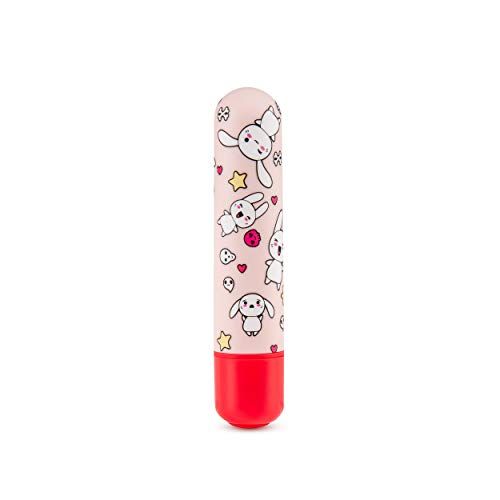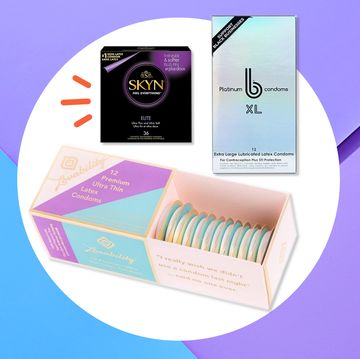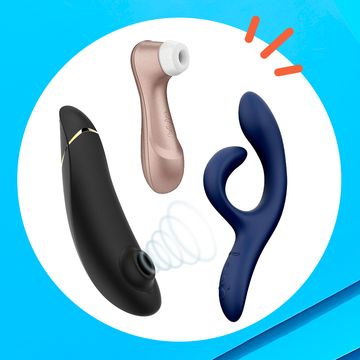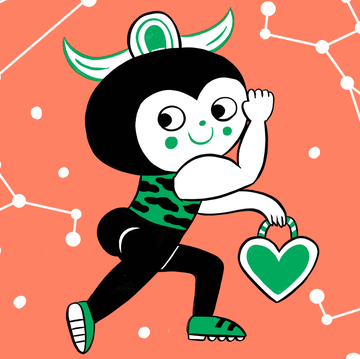For far too long, the narrative surrounding sex centered on how women can best please their partner. With the emphasis on giving pleasure, the receiving side to sex was often overlooked. Thankfully, society is moving past that dated, patriarchal outlook to realize that the female orgasm is an equally important part of sex, and should be a priority.
Still, the orgasm gap between men and women continues to exist today: Only 65 percent of heterosexual women say they always orgasm during sex, whereas a whopping 95 percent of heterosexual men say they always orgasm, according to a 2017 study published in Archives of Sexual Behavior. Whether this has any correlation to how sex has been regarded throughout history is a topic for another day, because it's about damn time, as Lizzo says, for women to close that gap and reclaim their orgasm.
The good news for people with vulvas is that the erectile tissue is spread out over a larger area, meaning more erogenous zones to enjoy and more ways to reach climax. That said, if you're trying to check off having different orgasm types on your bucket list, it's worth clarifying that there aren't so much as different types of orgasms as different ways to evoke the sensation. "Most researchers tend to believe that there’s really only one kind of orgasm that can be triggered by different parts of the body," says Vanessa Marin, a licensed psychotherapist who specializes in sex therapy and the creator of Finishing School, an online orgasm course for women.
Sheila Loanzon, MD, a board-certified obstetrician and gynecologist and a fellow of the American Congress of Obstetrics and Gynecology, agrees that there aren't clear orgasm categories. "Instead of thinking about kinds of orgasm, there are different ways that an orgasm can be reached," she explains. Sometimes, you aim to stimulate different areas to achieve an orgasm, and other times it could be a combination of factors. "There can be clitoral, vaginal, breast, inner thigh, toe sucking, oral, sensual massage, mental orgasms, and so many more," says Loanzon.
Although orgasms don't always have to be the end goal of sex or masturbation, they definitely have their benefits. And thanks to the wildly subjective nature of human pleasure, there's a whole bunch of ways to turn the elusive orgasm into an attainable one. But first, a refresher on all things O.
Meet the Experts:
Vanessa Marin, MA, MFT, is a licensed psychotherapist who specializes in sex therapy and the creator of Finishing School.
Sheila Loanzon, MD, is a board-certified ob-gyn and fellow of the American Congress of Obstetrics and Gynecology.
Jenni Skyler, PhD, is an AASECT-certified sex therapist and director of The Intimacy Institute.
Amy Levine is a sex coach and founder of Ignite Your Pleasure.
Alicia Sinclair is a certified sex educator and the CEO of b-vibe.
Jessica O’Reilly, PhD, is the author of The New Sex Bible and resident sexologist for ASTROGLIDE.
Christiane Northrup, MD, is an ob-gyn and author of Women's Bodies, Women's Wisdom.
Amanda Pasciucco, LMFT, is an AASECT-certified sex therapist and founder of Life Coaching and Therapy.
Debra Laino, PhD, is an AASECT-certified sex educator, board-certified clinical sexologist, and relationship therapist.
What is an orgasm?
"Clinically, an orgasm is the rhythmic contractions of the genitals," says Jenni Skyler, PhD, an AASECT-certified sex therapist and director of The Intimacy Institute. "It's the climatic peak of arousal in the human body."
During an orgasm, your vagina and uterus contract rapidly, and your heart rate, breathing, and blood pressure increases. But Skyler also describes an orgasm as "the ability to surrender to your utmost pleasure."
What does an orgasm feel like?
Considering that all bodies are different, what an orgasm feels like is entirely subjective. However, Skyler likes to describe it as a "pinnacle of pleasure, or the capacity for the whole body and genitals to feel alive and electric." Anecdotally, many vagina owners describe it as a "you know it when you feel it" kind of overwhelming sensation.
How long does an orgasm typically last?
Again, this depends on the person, but generally,"orgasms can last anywhere from a few seconds to 20 or 30 seconds," says Skyler. "For some women, it can last up to a minute, especially depending on if it's a multiple orgasmic experience."
What makes a female orgasm different from a male orgasm?
Male orgasms also have rhythmic contractions of the genitals and the pelvic floor, but in general, male orgasms are shorter than female orgasms. Men also have complimentary ejaculation, although "ejaculation and orgasm are actually separate events," explains Skyler. It just so happens that for penis owners, they typically happen at the same time, she adds.
Some people do experience female ejaculation, but it's not as common, notes Skyler, who emphasizes that that shouldn't feel like the goal, especially for women who are new to orgasms.
What’s the most common type of female orgasm?
While it may seem difficult to determine which kind of orgasm is the most common, most vulva owners need clitoral stimulation to have an orgasm, says Debra Laino, PhD, an AASECT-certified sex educator, board-certified clinical sexologist, and relationship therapist.
This is mainly "due to the majority of women needing clitoral stimulation to achieve orgasm, and the clitoris being the only organ on the human body whose sole purpose is sexual stimulation," she adds.
Can I have multiple orgasms in a row?
A multiple orgasmic experience is subsequent orgasms right after the other. "Some women can hit that orgasm, come off the peak for a moment, then hit it right away, right again," says Skyler.
"Some women are not multiply orgasmic either, and that's okay if you're not," adds Skyler. "But if you are multiply orgasmic, sometimes it's multiple orgasms in quick succession and sometimes it's a come down and rebuilding effect."
I've never orgasmed before, but I want to. How can I get there?
There's absolutely no shame in never having hit that particular pleasure peak. Let go of the pressure to orgasm, and focus on enjoying yourself. "Chasing it only makes it more elusive," says Skyler. Your brain becomes flooded with thoughts like, Is it gonna happen? When is it going to happen? Where is it?, which is what Skyler calls "an anxiety narrative" that will do nothing but sabotage your orgasm. Instead, she recommends surrendering to the sensations and allowing it to emerge.
For starters, relax your mood, environment, and overall attitude, as arousal cannot emerge without relaxation. And if arousal can't emerge, neither can orgasm, says Skyler, because "arousal is what the body needs to get hot and heavy." Once you're relaxed, you can really notice the sensations of arousal. So, instead of focusing on a desired end goal (orgasm), focus on how the present sensations make your body feel. Whatever feels good—keep doing that.
Pro tip: These vibrators can help.
This will help you get to know your body and figure out what you like, whether it's nipple stimulation or a fantasy that gets your juices flowing. Whatever helps you own your orgasm, know that the pinnacle of pleasure is possible. Start by trying these 11 ways to experience an orgasm and close that orgasm gap.
1. Clitoral orgasm
The clitoris is a small, nerve-dense structure seated at the top of the vaginal opening, and serves no function other than to provide sexual pleasure. "If you’ve never had an orgasm before, you want to start with the clitoris," Marin says.
How to have a clitoral orgasm: First things first, you need to figure out if you prefer direct or indirect stimulation, which is to say, touching the clitoris itself, or through the labia and clitoral hood. Marin suggests rubbing it with your fingers (rather than a sex toy) at first, "going in a spiral type of shape around your clitoris."
"Start pretty far from it and then spiral in closer to it until you’re finally spiraling over it, and then spiraling back out," she says. Note when and how your body responds: With that knowledge base, experiment with different types of touch until you find the one that works for you.
2. G-spot orgasm
"The G spot is a hypothesized highly erogenous area on the anterior (or front) vaginal wall of the urethral sponge that can be stimulated during sexual activity," Loanzon says. "It is the female equivalent to the prostate."
How to have a G-spot orgasm: "Pee first so you don’t hold yourself back from climax, as G-spot stimulation can lead to a need-to-pee sensation and female ejaculation," says Amy Levine, sex coach and founder of Ignite Your Pleasure. "Insert your middle finger in the vagina, on the belly-button side of the body. You’ll feel an area that’s likely corrugated in texture. Stop there and use a come-hither motion to stimulate or a toy rubbing or vibrating in that area."
Or, if you’re having penetrative sex, try a position that hits your G-spot—rear entry positions work well for this—and keep stimulating the area until you climax.
3. Blended orgasm
"Blended orgasms are combining clitoral stimulation with some kind of other stimulation, and that can actually be a great way—once you’ve mastered the clitoral orgasm—to figure out what other parts of your body feel like," Marin says. So, theoretically, you could achieve blended orgasm from stimulating your nipples and your clit simultaneously, but the most common combination is clitoris and G-spot.
How to have a blended orgasm: If you’ve got both the G-spot and the clitoral orgasm down, you’re in great shape—basically, just stimulate the G-spot at the same time as you stimulate your clit.
Or, if nipple tweaking, earlobe biting, or the anus are what get you going, focus your attention there. But for most people who have clitorises, involving that area will up your odds of achieving a blended orgasm.
4. Anal orgasm
"There are shared nerves from the anterior wall of the rectum to the vagina," Loanzon previously told Women's Health. "So for vagina owners, it may be possible for sexual arousal to occur from rectal stimulation," she says. Plus, the legs of the clitoris stretch all the way back to the anus, so back door stimulation can fire up the clit, too.
How to have an anal orgasm: Try incorporating your tried-and-true orgasm maneuvers into any anal adventure, advises Alicia Sinclair, a certified sex educator and CEO of sex toy company b-vibe. She also suggests easing into anal play by inserting a finger first, "so that you can be the giver and receiver." Use lots of lube, too, and work your way in slowly.
"When you put something inside the anal canal, push up in the same way toward the belly button, as you would in the vagina," Sinclair says. That way, "you have that same possibility of stimulating that central nerve area," she adds.
5. C-spot orgasm
The C-spot is your cervix, and involves nerve endings located in the cervix and around the uterus. Anatomical differences and surgical history—i.e., a hysterectomy that involves the cervix's removal—can affect a person's ability to achieve cervical orgasm, as can a partner's penis or dildo size. Heavy thrusting with a particularly well-endowed partner may hurt, so communicate about how cervical stimulation feels for you.
How to have a cervical orgasm: The key to a cervical orgasm is the build-up, says Jessica O’Reilly, PhD, author of The New Sex Bible resident sexologist for ASTROGLIDE. You have a better chance of achieving one—and of enjoying pleasurable, rather than painful, C-spot sensations—if you’re very turned on. So, save deep penetration until you’re close to climax, and then have your partner thrust (or use a sex toy or finger) so they hit your cervix.
6. Nipple orgasm
You probably already know where and what the nipples are, but what you might not know is that some people can orgasm solely from their stimulation. In one study of 213 women, 29 percent reported having had a breast-based orgasm at some point in their lives, Men’s Health reported.
"When the nipples are stimulated, oxytocin is released, which causes the same uterine and vaginal contractions associated with orgasm," says ob-gyn Christiane Northrup, MD, author of Women's Bodies, Women's Wisdom. "This brings more blood flow to the genitals and can trigger an orgasm."
How to have a nipple orgasm: "When it comes to nipple/breast pleasure, I wouldn’t get too hung up on the goal of orgasm," O’Reilly says. "Focus on the pleasure and see where it leads."
O'Reilly recommends experimenting with the area right above the areola, which many people find to be the most touch-sensitive. "Start on the outer edges, using the backs of your fingers, and circle your way slowly into the center," O'Reilly says. You can also roll the nipple between thumb and forefinger.
Some people may find it feels great to have a partner breath on, lick, suck, or pinch the nipples. This is all subjective, so it's a matter of playing around to determine what feels best for you. A light touch—at least at first—may be best for breast action. Try gentle boob cupping while stimulating the nipples with a tongue or vibrator, rather than full-on grabbing.
7. Coregasm
A coregasm is "when you work out and you have orgasms" just from the physical activity, Marin says.
How to have a coregasm: Unfortunately, this may not be something you can train your body to do. "It seems to be people are kind of born doing that. and it kind of tends to be an annoyance, more often than not," Marin says. Because yeah, exercising in a crowded gym and not being able to stop yourself from climaxing can get...awkward.
Typically, Marin explains, coregasms happen in two ways: "One is from running, where your thighs might be rubbing together and you’re getting a little bit of indirect clitoral stimulation." But the more common one is from core workouts. "Some people with vaginas will have them from just doing sit-ups," she says. "Others experience them from yoga-type practices, or being in a bridge position where you really have your core engaged." So maybe it's more of an at-home workout type of experimentation...
8. Skin orgasm
A skin orgasm is also called "frisson," like the tingle that runs through your limbs when you hear a particularly affecting song. Maybe you get goosebumps, maybe your hair stands up, or maybe you get a little shiver.
How to have a skin orgasm: Research shows that skin orgasms are most commonly triggered by music—but emotionally evocative scenes in movies, moving artworks, or even other people with whom you feel a very special connection can spark frisson. It’s an unpredictable one, though.
9. Breath orgasm
"Sex is often pigeon-holed into a physical act involving the genitals, but the reality is that the hottest sex happens between our ears—and is often enhanced by how we use our breath and lungs," O'Reilly says. "Your breath impacts your interpretation of sensations and helps to put your mind into a state conducive to experiencing pleasure." Which is to say, you can in fact breathe your way to climax—while also dismissing the intrusive thoughts that can distract from pleasure, O'Reilly adds.
How to have a breath orgasm: First things first: O'Reilly suggests finding a quiet, comfortable place to lie down on your back. Placing your hand on your belly, breathe in deeply through your nose, such that you can feel your hand rise and fall, and exhale through an open mouth. Slowly, begin a mental scan of your body from head to toe, actively relaxing each body part as you go.
"The way you breathe has a significant impact on your sexual and orgasmic response," O'Reilly explains. "And though each of our bodies is unique, many people report that deep, slow breathing intensifies their orgasms and can even result in multiple climaxes."
But because everyone orgasms differently—whether from breathing exercises or physical touch—there's no right way to do this: "You have to experiment with different types of breathing to see what works for you," she continues, whether that's rapid, shallow breaths, slow, deep breaths, inhalation through the nostrils, or any other type of breathing that feels especially good to you as you imagine yourself in an arousing scenario.
10. Fantasy orgasm
"So powerful is the mind’s hold over our sexuality that some people can actually 'think' themselves off," says O'Reilly. This one is pretty self-explanatory: Fantasizing your way to climax means not touching your body, just flexing your mind muscles until you peak. Often, breath work and fantasy will go hand-in-hand—you may well find that visualizing scenarios and your body's response works best in conjunction with breathing exercises.
How to have a fantasy orgasm: "Though only a small percentage of people report being able to reach orgasm through fantasy alone, you may want to experiment with the power of your mind," O'Reilly says. "Allowing your mind to wander into uncharted territory can help you to recognize and benefit from your most genuine fantasies and untapped desires."
Don't place any fantasy off limits; just let your mind go where it wants to go. Focus on your sexiest possible scenario—while also engaging whatever breath work feels best to you—and immerse yourself in it, imagining the touch and the atmosphere. Really get yourself into the scene, and just keep using your imagination until you and your fantasy self climax.
11. Sleep orgasm
"People of all genders can have orgasms in their sleep. Orgasm happens in the brain, and the brain is quite active at night,” says Marin.
How to have a sleep orgasm: "Unfortunately, there’s no way to make yourself have a sleep orgasm. They’re fun when they happen, but you can’t do anything to create them," she says. Darn.
What are some of the health benefits of orgasms?
Sure, they feel great, but orgasms have even more to offer, too. Aside from becoming more aware of your body's wants and needs, here are a few more perks from the experience.
1. They're a mood booster: When you orgasm, feel-good chemicals like dopamine and oxytocin are released. "Dopamine is a reward chemical and oxytocin is an attachment chemical," Laino explains. "These two come on strong with orgasms, and are important components to health."
2. You can strengthen your pelvic floor: Pelvic floor health is crucial. Luckily, your orgasms help contract those muscles, which is important for preventing urinary incontinence and avoiding prolapse, says Laino.
3. They help your immune system: That dose of hormones you release during orgasm strengthens your immune system with a nice little boost, too, according to Laino. Especially if you're doing so around once a week.
4. You'll sleep better: Have trouble falling asleep? An orgasm might be the key to a good night's rest. "Orgasms can improve sleep because of endorphins and some mood stabilizing hormones such as serotonin as well as the muscle relaxation that comes from tensing up and releasing," says Laino.
There's research backing this up, too: Thirty-two percent of 1,866 U.S. women who reported masturbating in the previous three months did so to help go to sleep according to a 2000 study, adds Amanda Pasciucco, an AASECT-certified sex therapist and founder of Life Coaching and Therapy.
They help with pain: Whether you're struggling with period cramps, headaches, or chronic conditions, orgasms can help temporarily alleviate pain, says Laino. In fact, the above study also noted that nine percent of about 1,900 U.S. women who reported masturbating over the span of three months did so to relieve menstrual cramps.
So go ahead, and give a few of these techniques a whirl! Not only will your sex life improve, but your mind and body will benefit, too.
Claire is a freelance writer covering sex and gender. Formerly a Fulbright fellow, she now lives in Brooklyn with her cat, Porkchop. You can read her work on her website, clairelampen.com.
Hunter Levitan is a freelance journalist specializing in fashion, style, culture, sex, and wellness stories, as well as a writer/poet, photographer, and mixed media brand consultant. Her work has appeared in Who What Wear, Cosmopolitan, Women’s Health Magazine, and The Improper Bostonian, among others. She is a graduate of New York University and lives in New York City.
Sabrina is an editorial assistant for Women’s Health. When she’s not writing, you can find her running, training in mixed martial arts, or reading.













